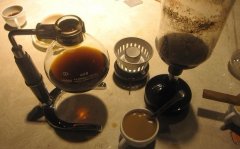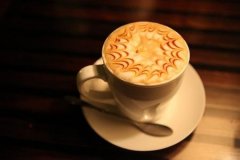Coffee common sense siphon coffee brewing skills
1. There is also "stewing" in siphon steaming. The expression of this process in siphon cooking is that coffee powder absorbs water at a certain temperature, and the ingredients in coffee powder are exchanged by the principle of heat exchange. during the exchange, various ingredients in the coffee will release gas because of the temperature, forming the phenomenon of expansion, and keeping the temperature in a state of non-boiling can make the "steaming" continue. Dissolve the high-quality ingredients in the coffee, and the "thick", "hierarchical" and "three-dimensional" tastes described in the book can appear.
two。 Some people suggest that you should not use the way of drawing circles when stirring, but can use the way of turning left and right. This method is afraid that if you draw more circles, it will be more sour. In fact, as long as you have enough training, you can certainly complete the stirring action in two or three circles. After all, turning a circle is easier to learn. When you are proficient in one skill, you can refer to other mixing methods, which can get twice the result with half the effort.
3. The timing of the second stirring is not judged by the condition of the current, but by the time when the bubble begins to melt, that is, similar to the follicular flushing method, when the coffee powder expands to a certain extent after the first flushing, the time to stop the water is only not very obvious in the siphon cooking method and must be observed in many ways. The purpose of the second stirring is to dissolve the ingredients after stewing into the water, so that the taste of the coffee is complete, while another purpose of the second stirring is to make up for the deficiency of the first stirring. If the first stirring is not successful, it must be remedied by the second stirring earlier, although the effect is limited, it is always better than nothing! So the success of the first stirring has determined the quality of the coffee!
4. If the coffee is not properly preserved or damp or too long to make the coffee not fresh, the gas in the coffee beans will be lost, and this "stewing" process will not even be formed. in the same way, if the cooking method is improper (such as stirring too much), the process will also disappear. so the action of stirring is to make a proper combination of coffee and water to produce a "steaming" effect, its importance is self-evident, this is another reason why coffee is not cooked well.
5. As far as the cooking process is concerned, the length of time is not the decisive factor. If the time is too short, if the ingredients are not released enough, of course, the taste will not be enough. A longer time (of course, not as long as 3-5 minutes) will make the coffee concentrated and taste stronger, but it is not the main cause of coffee acid, bitterness and astringency. The coffee will be too sour because it is stirred too much, and the bitter taste is that the water temperature is too high. The sour and astringent taste is that the water temperature is not enough (the premise is that the proper coffee is roasted properly, because improper roasting will also make the coffee sour, bitter and astringent), all of the above will suppress the release of the fragrance, and the sweet taste is of course very difficult to appear, if the coffee beans are not fresh, the steaming effect will not be obvious, after cooking, when the upper pot of coffee flows to the next pot beaker, the bubbles will be loose and disappear quickly, and the smell will be poor.
6. In order to cook the siphon well, the first is the control of the water temperature, and then the way of stirring, so it is strongly recommended to buy a bar stove with adjustable firepower, and please strengthen the touch between the mixing stick and the coffee powder!
7. As far as siphon cooking is concerned, the change of water temperature has a great influence on coffee. For example, the rising temperature of 95 degrees and the falling temperature of 95 degrees are completely different, which you have to consider carefully.

Important Notice :
前街咖啡 FrontStreet Coffee has moved to new addredd:
FrontStreet Coffee Address: 315,Donghua East Road,GuangZhou
Tel:020 38364473
- Prev

Fine Coffee learn the skills and steps of siphon pot brewing coffee
The skill of brewing coffee in a siphon pot is related to several aspects: whether the beans are lightly roasted; second, to see if the amount of coffee powder can be properly increased; and third, to increase the time for stuffy cooking. Siphon is a very fun and technical way, I personally like it. Production steps: step 1: select the appropriate thickness of ground beans, for siphon coffee
- Next

Siphon tube is the most commonly used method in traditional coffee shops.
Siphon tube is the most commonly used method in traditional coffee shops. when cooking, it is not only full of taste and smell, but also has the effect of visual display, but the quality of coffee varies greatly from person to person, which is the most criticized place. The complexity of the cooking process (pay attention! It is complexity, not difficulty) that leads to the decline of siphon type in various other ways.
Related
- What is the Philharmonic pressure? How to use Philharmonic pressure to make delicious coffee
- Why does a hand grinder have more fine powder than an electric grinder?
- In addition to the hot mom, what is the difference between the versions of EK43 | ditting and Mahdi ek43?
- What kind of equipment do you need to make coffee by hand? Introduction to novice starter cooking equipment tools
- Espresso needs to be ground how thick and thin scale entry Italian Coffee Machine Bean Grinder investigation and Grinding course
- How much does it cost to open a small private cafe? How much does it cost to learn coffee? How to operate it?
- The difference between the flavor characteristics of hand-brewed coffee and coffee maker is hand-brewed coffee really better than coffee maker? Can I use a coffee machine to make coffee beans by hand?
- The difference between 01 and 02 of hario v60 filter cup what is the difference between 01 and 02 filter cup opening and cooking flavor
- What's the difference between the smart cup and the French kettle? Which is better, the French kettle or the Smart Cup?
- What's the difference between a smart cup and a V60 filter cup? The difference between the taste of smart cup and hand-brewed coffee

